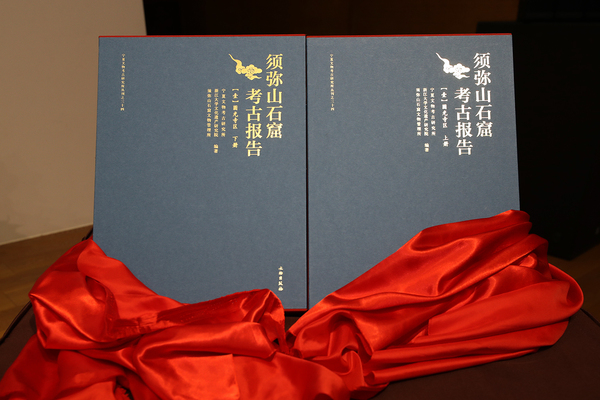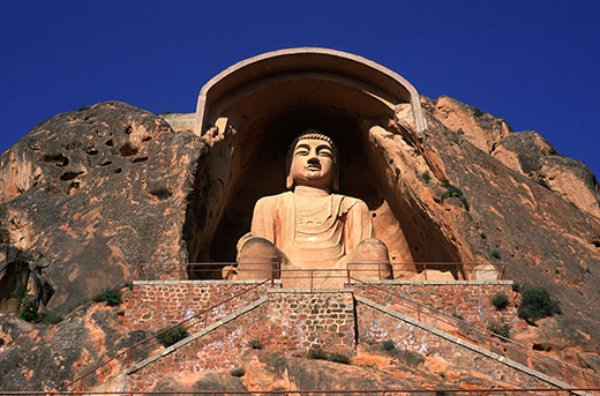The 1,500-year-old Xumishan Grottoes, located in Guyuan City in Ningxia Hui Autonomous Region, is home to over 160 caves and more than 1,000 statues.
Standing on Mount Xumi, one can see uniquely charming grottoes, Buddha statues, temples, ancient trees and strange rocks. No one would have imagined that what was a little-known mountain decades ago has become a famous historical and cultural scenic spot.

This change is intimately bound up with the unswerving efforts of archaeologists.
Recently, The Archaeological Report on Yuanguang Temple in Xumishan Grottoes was released. This work, published by the Cultural Relics Publishing House, was co-compiled by Ningxia Institute of Cultural Relics and Archaeology, Institute of Cultural Heritage at Zhejiang University, and Institute of Relics in Xumishan Grottoes. It chronicles the fruitful results achieved in the archaeological investigation of the Xumishan Grottoes, providing a new and panoramic picture of an important grotto complex in Northwest China and presenting the immortal grotto culture to the public.
Xumishan Grottoes: precious treasure of Buddhism
From the 1950s to the present, three large-scale archaeological investigations have been carried out in the Xumishan Grottoes. It is an extremely arduous journey which involves the sustained and devoted efforts of Chinese archaeologists.
SU Bai, a distinguished archaeologist in China, is the promoter and leader of the archaeological activities of the Xumishan Grottoes. "To excavate the treasures of the Xumishan Grottoes as soon as possible is a common long-cherished dream of different generations of archaeologists represented by SU Bai," said a researcher at Ningxia Institute of Cultural Relics and Archaeology.
"In addition to the entire Xumishan archaeological team, this report has also incorporated the valuable contributions from frontline field archaeologists in the Yungang Grottoes, the Longmen Grottoes, the Kizil Caves, the Maijishan Grottoes and the Dazu Grottoes. It has also received helpful guidance from scholars in the archaeological community and experts in local museums," said LI Zhirong, vice director of the Institute of Cultural Heritage at Zhejiang University and one of the leaders in the Xumishan archaeological project.

The Xumishan Grottoes is geographically important. Since ancient times, it has been a transportation hub and a strategic site connecting the Central Plains with the Hexi Corridor and the southern and northern regions of the Gobi Desert. With the advent of the Silk Road, it has become a must-travel site on the northern route of the eastern section of the Silk Road. This convenient geographic access allowed for the formation of the largest Buddhist temple complex in Northwest China which occupies a pivotal position in the development of China's grotto culture.
Stone statues in the Xumishan Grottoes are featured by their various shapes and exquisite carving skills. The sitting Maitreya Buddha statue at the entrance of Mount Xumi is the most striking. As the largest statue in the Xumishan Grottoes, it becomes the hallmark of Mount Xumi. Carved in a horseshoe-shaped grotto, it is remarkably imposing with a solemn look.
Archaeological report unfolding the compelling story 1,500 years ago
Archaeological reports have long been the focus of archaeological research and heritage conservation.
"Archaeology is a multi-disciplinary and inclusive subject, involving a wide spectrum of fields, such as history, archaeology, architecture, philosophy, religion, art and paleography," said SUN Yingmin, director of the Grotto Committee of ICOMOS China.
The Archaeological Report on Yuanguang Temple in Xumishan Grottoes aims at documenting the archaeological findings of the Xumishan Grottoes in an objective, faithful and complete manner, thus providing academia with an ocean of reliable first-hand information. On this basis, a database about the Xumishan Grottoes will be thus established.
This wide-ranging archaeological report is really phenomenal, with each page unfolding the compelling story 1,500 years ago.
According to the report, there are 14 caves in Yuanguang Temple. Cave 45 and Cave 46, located on the second floor of the main hall, are the most magnificent ones in the temple. They are also home to the most surviving statues in Mount Xumi. Cave 45 is sizable, with an overall depth of 6 meters and a height of 4.1 meters. Though subjected to constant wind erosion, more than 40 statues, ranging from 1.8 meters and 2.5 meters in height, have survived intact. These statues are precious artworks for the study of statuary in the Northern Dynasty.
The report is teeming with elaborate works like this. Each and every one of them is original and priceless.
"The archaeological survey and excavation of grotto temples and the compilation of the report not only lay a foundation for the study of grotto temples but also inject a wealth of information into different fields of study," said SUN Yingmin.
The report is, so to speak, an encyclopedia documenting the past and present of the archaeological site of the Yuanguang Temple Grottoes. It is also an exquisite scroll displaying a panoramic view of the superbly exceptional carving art and a guidebook providing researchers and visitors with extensive information about the Yuanguang Temple Grottoes.
Archaeology plus digital technology
The wide application of digital technology is the defining feature of the archaeological excavation of the Xumishan Grottoes and the report.
"This report adopts archaeological research methods, especially the subtle use of digital gauging and mapping technology, which improves mapping precision considerably and makes a detailed account of all the repair and restoration work," observed SONG Xinchao, director of the National Cultural Heritage Administration.
The Xumishan archaeological team experimented with the fusion of archaeology and computer technology. "It is far from a "1 + 1" thing in combing grotto archaeology and computer technology. How can we develop, improve and adapt computer technology in archaeological research? This poses a tremendous challenge to us," said XU Duanqing, director of Computer Basic Teaching Center at Zhejiang University and one of the leaders in the Xumishan archaeological project.
To support the Xumishan archaeological project, Zhejiang University set up a team dedicated to digitalizing cultural relics. "We used photogrammetry, upgraded it little by little, and tried to integrate laser scanning with photogrammetry so as to achieve greater accuracy in recording details and textures," said DIAO Changyu, vice director of the Institute of Cultural Heritage at Zhejiang University.
In 2020, they made a stride into building and using a large-scale computing platform.
"These changes are driven by the need for the archeological excavation of the Xumishan Grottoes," said DIAO Changyu.
"Our work always lies in the field. New technology is to our work what hands and feet to human beings. It is a valuable tool of empowerment," LI Zhirong stressed.
Source: translated from Guangming Daily






